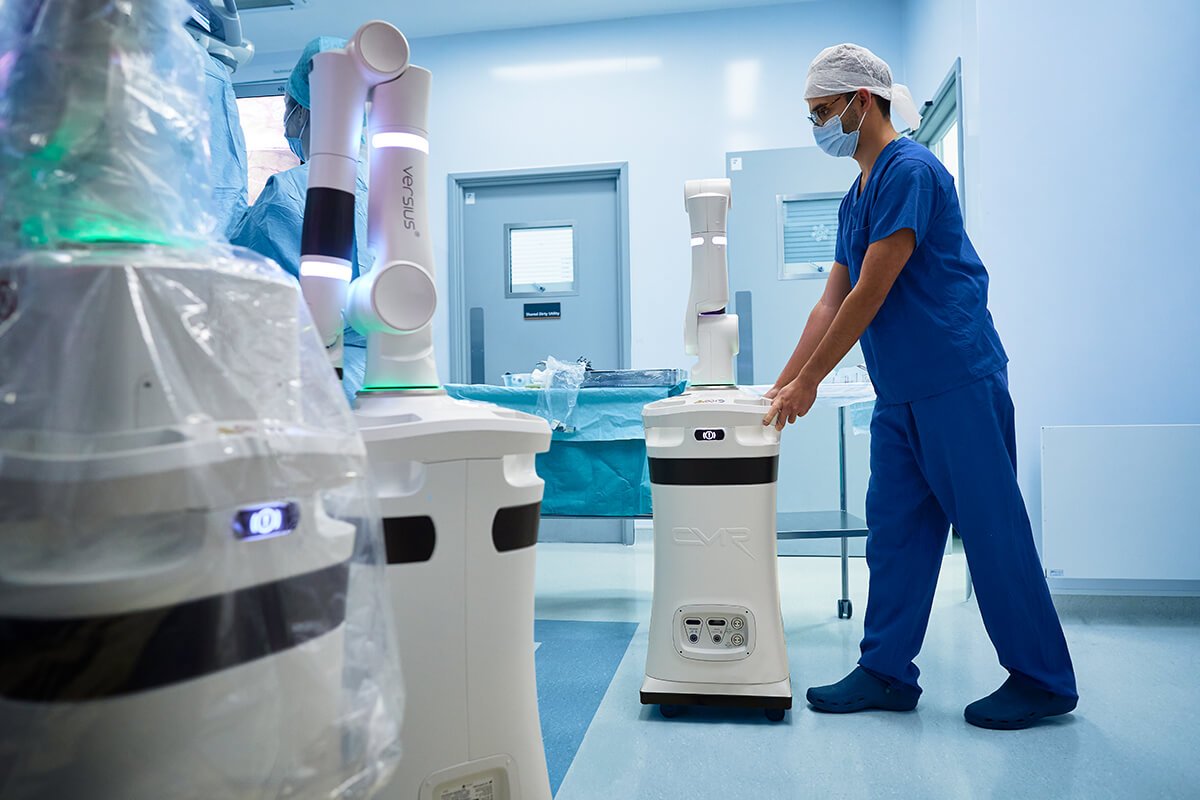Robotic surgery: Precision beyond human limits
The robotic surgery explosion
Surgical robotics represents one of the fastest-growing sectors in healthcare technology, with the global market valued at $12.5 billion in 2025. This remarkable growth trajectory is expected to continue, with projections showing the market will reach $45.93 billion by 2034, growing at an impressive CAGR of 15.6%.
North America leads this revolution, commanding 51% of the market share in 2024. This dominance is primarily driven by high healthcare spending and rapid adoption in US hospitals. Worldwide, the number of medical robot units is expected to increase dramatically, from 713 in 2016 to over 2,100 by 2025.
From sci-fi curiosity to everyday essential
What started as experimental technology has rapidly become standard practice in operating rooms around the world. Just look at these adoption rates:
87% of prostatectomies in 2019
60.8% of hysterectomies in 2018
18% of mitral valve repairs in 2020
This isn't just doctors being tech enthusiasts – these impressive numbers reflect real improvements in patient outcomes. Robotic surgery isn't just cool; it's genuinely making a difference in people's lives.
The tech titans of the OR
The surgical robotics field features some fascinating players, each with their own unique approach:
Intuitive Surgical leads the soft-tissue surgery market with its da Vinci platform, specializing in urology and gynecology procedures. The company's success comes from its large installed base, comprehensive surgeon training programs, and an integrated closed-system approach using proprietary instruments.
Stryker has become the orthopedic champion with its Mako system, specializing in joint replacements. Its technology focuses on ultra-precise bone preparation and implant placement; the results speak for themselves. Studies show that knee replacements using the Mako system reduced 90-day care costs by $2,400 and slashed readmission rates by 33% compared to traditional surgery.
Medtronic is taking a more versatile path with its Hugo RAS system for soft-tissue procedures and Mazor platform for spine surgery, emphasizing cost-effectiveness and flexibility.
Meanwhile, newer players like CMR Surgical (Versius) and Distalmotion (Dexter) are creating more modular, compact platforms, making robotic surgery accessible to smaller hospitals and diverse settings.
Cool startups to watch
Moon Surgical has created the Maestro system, which cleverly combines robotics, machine vision, and AI-guided assistance to enhance laparoscopic procedures. They recently hit an amazing milestone – 1,000 patients worldwide have now been treated with their platform!
Microsure is doing incredible work in supermicrosurgical robotics with its MUSA system, enhancing precision for delicate procedures like lymphatic and nerve surgery. Their technology enables surgeons to operate on sub-millimeter anatomical structures in a more comfortable setting, working toward making microsurgery more widely available to patients.
🦸🏻♂️ AI assistants and superhuman abilities
Today's surgical robots are also getting smarter, with AI that helps with real-time decision-making, image analysis, and workflow optimization. These systems enhance imaging by connecting with advanced technologies like intraoperative MRI or CT, helping surgeons spot critical structures with incredible precision.
Modern robotic instruments offer degrees of freedom that go far beyond what human hands can do naturally. With features like 360-degree rotation, these tools can move in ways that are physically impossible for a human wrist, allowing for precise movements in tight spaces.
High-definition 3D visualization gives surgeons a magnified view of the surgical field, dramatically improving accuracy compared to traditional approaches.
Real results driving the robot boom
Impressive clinical outcomes back the enthusiasm surrounding surgical robotics. Over 3.7 million total hip and knee replacements were performed in the US from 2012-2023, with a growing percentage using robotic assistance.
Robotic systems consistently deliver reduced blood loss, lower infection rates, less post-operative pain, quicker recovery times, and shorter hospital stays.
For surgeons themselves, these platforms offer better ergonomics, reducing physical strain during lengthy procedures, potentially extending careers, and improving performance. Less tired surgeons mean better outcomes for all of us!
Hurdles still to overcome
Despite all this amazing progress, several significant challenges remain:
The price tag issue: These systems aren't cheap! The initial investment typically ranges between $1.5 million and $2 million, with additional expenses for maintenance, disposable instruments, and software updates. These costs can be prohibitive for smaller hospitals and healthcare systems.
The learning curve and tech limitations: Mastering robotic surgery requires extensive training and practice. Operating room staff must also learn to work effectively with these systems, adding complexity to implementation.
While AI can assist wonderfully, fully autonomous surgery remains a distant goal. Human oversight is essential, particularly in complex or unexpected situations.
Looking to the future: Global expansion and growth
The global footprint of surgical robotics continues to expand. While Intuitive Surgical leads worldwide, it faces increasing competition in Europe and Asia from companies like CMR Surgical. Medtronic and others are pushing into emerging markets with more affordable systems, potentially democratizing access to this revolutionary technology.
Key developments on the horizon include more affordable portable systems, enhanced AI capabilities, better hospital IT integration, and remote surgery capabilities reaching underserved areas.
As technology continues to evolve, it is clear that surgical robots will become even more integral to the operating room, improving patient outcomes and redefining the future of surgery.
📫 Subscribe to the Healthy Innovations newsletter for your weekly dose of medical advances, from AI diagnostics to gene therapies, delivered in a concise 5-minute read.



